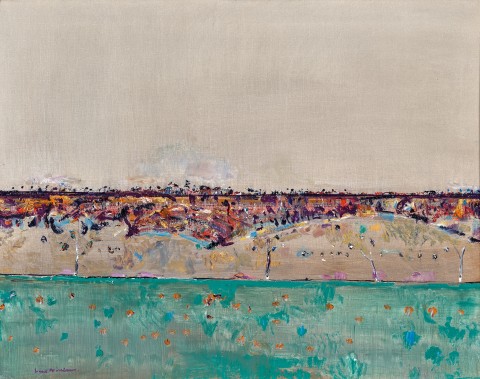LYSTERFIELD PADDOCK NO. 1, 1973
FRED WILLIAMS
oil on canvas
71.0 x 92.0 cm
signed lower left: Fred Williams.
Rudy Komon Gallery, Sydney
Joseph Brown Gallery, Melbourne, acquired from the above April 1977
Mr Alan Greenway, Australia and USA, acquired from the above
Thence by descent
Private collection, California, USA
Lysterfield Paddock no. 2, oil on canvas, 38.0 x 76.0 cm
The 1960s began optimistically for Fred Williams. In 1963, he was invited to join the stable of artists represented by Sydney art dealer, Rudy Komon, and the monthly retainer he received gave Williams and his wife, Lyn, the financial confidence to buy a house at Upwey in the Dandenong Ranges. That same year Williams was awarded the Helena Rubinstein Travelling Art Scholarship, spending seven months in Europe in 1964. The following year was also significant – ‘for the first time [Williams] was able to paint full-time. The concentration and energy, and the time he now brought to his art, resulted in four years of astonishing variety and contrast in his painting.’1
From the beginning of his career Williams drew on his experience of the surrounding world as the source of subject matter for his art and the landscape of Upwey naturally featured in his paintings at this time. From mid-1965, nearby Lysterfield, which was just a short drive from his home, became a regular destination for outdoor painting trips. James Mollison, the artist’s great friend who accompanied him on some of these excursions, described the area at the time as ‘sparsely settled country, with gently rolling hills and scrubby paddocks – fenced, but otherwise showing few signs of habitation’.2 It was the perfect subject for an artist who used his immediate surroundings as a jumping off point for images which distilled the landscape to its essential elements, and in the process, created archetypal images which have become part of our collective visual memory.
Painted on 29 August 1973, Lysterfield Paddock no. 1 features the broad open landscape divided into three horizontal bands. The lower half of the picture comprises a deep foreground which is painted a brilliant blue-green and enlivened by a series of darker blue-green and earth-coloured daubs representing low, irregular growth. Above it, in the middle-ground, gentle rolling hills sit below a decisive horizon line, while the top half of the picture is devoted to the depiction of the sky, big, clear and luminous, and injecting a palpable sense of light and space into the composition. The hieroglyphic-like marks that Williams used to describe the scrubby growth across the hillside, and the trees lining the horizon, are distinctively his, and typical of what Patrick McCaughey described as ‘his refined method of painting’ which was by this time, ‘as spontaneous as handwriting.’3 Less familiar are the four tall trees, which are lined up along the base of the hillside. White with touches of dark colour, and totally devoid of foliage, they are like sentinels in the landscape. Indicative of Williams’ careful observation of his environment, these trees are also an example of his occasional habit of incorporating details which identify landscape subjects – sometimes viewed during a particular season or time of the day – as specific, recognisable locales, rather than a more generalised view.
This painting was owned by Alan Greenway (1927 – 2008), who founded TraveLodge Australia in 1957, and initiated the Travelodge Art Prize.4 A national invitation prize, it was awarded to Williams’ good friend, John Brack, in 1971.
1. McCaughey, P., Fred Williams 1927 – 1982, Murdoch Books, Sydney, revised edition, 1996, p. 166
2. Mollison, J., Fred Williams: A Singular Vision, Australian National Gallery & Oxford University Press, Canberra, 1989, p. 100
3. McCaughey, op. cit., p. 184
4. Atkinson, B. and Stephens, T., ‘Alan Greenway, Leader in Tourism 1927 – 2008’, Sydney Morning Herald, 19 January 2009, https://www.smh.com.au/national/promoter-of-australian-tourism-started-c...
KIRSTY GRANT
